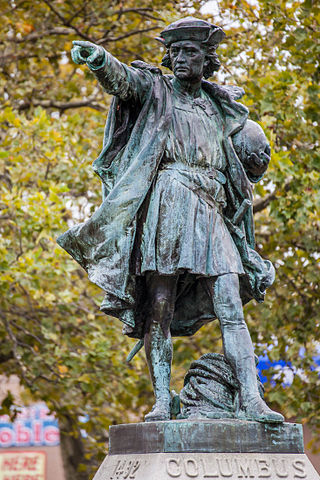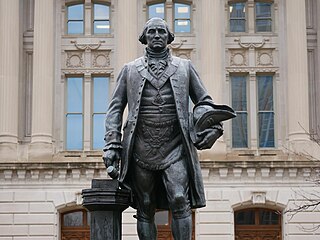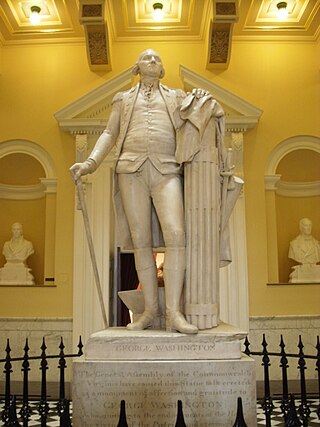
Bronze is the most popular metal for cast metal sculptures; a cast bronze sculpture is often called simply "a bronze". It can be used for statues, singly or in groups, reliefs, and small statuettes and figurines, as well as bronze elements to be fitted to other objects such as furniture. It is often gilded to give gilt-bronze or ormolu.

William Rush was a U.S. neoclassical sculptor from Philadelphia, Pennsylvania. He is considered the first major American sculptor.

Jo Davidson was an American sculptor. Although he specialized in realistic, intense portrait busts, Davidson did not require his subjects to formally pose for him; rather, he observed and spoke with them. He worked primarily with clay, while the final products were typically cast in terra-cotta or bronze, or carved from marble.

Randolph Rogers was an American Neoclassical sculptor. An expatriate who lived most of his life in Italy, his works ranged from popular subjects to major commissions, including the Columbus Doors at the U.S. Capitol and American Civil War monuments.

The Chimera of Arezzo is regarded as the best example of ancient Etruscan art. The British art historian David Ekserdjian described the sculpture as "one of the most arresting of all animal sculptures and the supreme masterpiece of Etruscan bronze-casting". Made entirely of bronze and measuring 78.5 cm high with a length of 129 cm, it was found alongside a small collection of other bronze statues in Arezzo, an ancient Etruscan and Roman city in Tuscany. The statue was originally part of a larger sculptural group representing a fight between a chimera and the Greek hero Bellerophon. This sculpture is likely to have been created as a votive offering to the Etruscan god Tinia and is held by the National Archaeological Museum, Florence.

The United States Capitol building features a central rotunda below the Capitol dome. Built between 1818 and 1824, the rotunda has been described as the Capitol's "symbolic and physical heart".

The Victorious Youth, Getty Bronze, also known as Atleta di Fano, or Lisippo di Fano, is a Greek bronze sculpture, made between 300 and 100 BC, in the collections of the J. Paul Getty Museum, Pacific Palisades, California. Many underwater bronzes have been discovered along the Aegean and Mediterranean coast; in 1900 sponge divers found the Antikythera Youth and the portrait head of a Stoic, at Antikythera, the standing Poseidon of Cape Artemision in 1926, the Croatian Apoxyomenos in 1996 and various bronzes until 1999. The Victorious Youth was found in the summer of 1964 in the sea off Fano on the Adriatic coast of Italy, snagged in the nets of an Italian fishing trawler. In the summer of 1977, The J. Paul Getty Museum purchased the bronze statue and it remains in the Getty Villa in Malibu, California. Bernard Ashmole, an archaeologist and art historian, was asked to inspect the sculpture by a Munich art dealer Heinz Herzer; he and other scholars attributed it to Lysippos, a prolific sculptor of Classical Greek art. The research and conservation of the Victorious Youth dates from the 1980s to the 1990s, and is based on studies in classical bronzes, and ancient Mediterranean specialists collaboration with the Getty Museum. The entire sculpture was cast in one piece; this casting technique is called the "lost wax" method; the sculpture was first created in clay with support to allow hot air to melt the wax creating a mold for molten bronze to be poured into, making a large bronze Victorious Youth. More recently, scholars have been more concerned with the original social context, such as where the sculpture was made, for what context and who he might be. Multiple interpretations of where the Youth was made and who the Youth is, are expressed in scholarly books by Jiri Frel, Paul Getty Museum curator, from 1973 to 1986, and Carol Mattusch, Professor of Art History at George Mason University specializing in Greek and Roman art with a focus in classical bronzes.

Michelangelo's David have been made replicas for numerous times, in plaster, imitation marble, fibreglass, snow, and other materials. There are many full-sized replicas of the statue around the world, perhaps the most prominent being the one in the original's position in the Piazza della Signoria in Florence, Italy, placed there in 1910. The original sculpture was moved indoors in 1873 to the Accademia Gallery in Florence, where it attracts many visitors. Others were made for study at art academies in the late nineteenth century and later, while the statue has also been replicated for various commercial reasons or as artistic statements in their own right. Smaller replicas are often considered kitsch.

Columbus is a historic statue in Johnston, Rhode Island. The statue is a bronze cast of a sterling silver statue which was created by Rhode Island's Gorham Manufacturing Company for the 1892 World's Columbian Exposition in Chicago. The original silver statue was not meant for permanent exhibition, but rather as a demonstration of the skills of the Gorham Company, and was later melted down. The bronze cast was dedicated on November 8, 1893, in Columbus Square, in Providence, Rhode Island, United States as a gift from the Elmwood Association to the City of Providence.

George Washington is a public artwork by American sculptor Donald De Lue, located on the grounds of the Indiana Statehouse, in Indianapolis, Indiana, United States. The bronze statue of George Washington that occupies the Indiana Statehouse south lawn is one of several copies of a 1959 original wax cast at the Modern Art Foundry in Long Island, New York.

George Washington is a statue by the French sculptor Jean-Antoine Houdon from the late 18th century. Based on a life mask and other measurements of George Washington taken by Houdon, it is considered one of the most accurate depictions of the subject. The original sculpture is located in the rotunda of the Virginia State Capitol in Richmond, Virginia, and it has been copied extensively, with one copy standing in the United States Capitol Rotunda.
Julie Rotblatt-Amrany is an American sculptor and painter, whose work explores the resurgence of the figure in modern art.

Stuart Williamson is a sculptor, teacher of sculpture and poet from North East England. He is a Fellow of the Royal British Society of Sculptors, a Member of the Society of Portrait Sculptors (UK), a Member of the National Sculpture Society (USA), and a Founding Member of the Portrait Sculptures Society of America. He is also a Member of the Salmagundi Club in Manhattan and was featured in their American Masters show in 2015.

Christopher Columbus, or simply Columbus, is a 1955 sculpture by Edoardo Alfieri, originally installed outside Columbus, Ohio's City Hall, in the United States. The statue was unveiled in 1955, celebrating Christopher Columbus's voyages to the New World. It was removed in July 2020, in light of the explorer's abusive relationship with indigenous Americans.

Governor James A. Rhodes is a 1982 bronze statue depicting Ohio governor Jim Rhodes by Gary Ross, installed along East Broad Street in front of the Rhodes State Office Tower in Columbus, Ohio, United States.

A 1959 statue of Christopher Columbus by Alfred Solani was installed on the Columbus State Community College's downtown campus in Columbus, Ohio, United States. The monument is one of three in Columbus commemorating the explorer. The statue was removed June 19, 2020.
The Newsboy is a bronze sculpture of a newspaper carrier in Columbus, Ohio, United States. The statue, created by artist Bruce Hanners, is located outside the 8 on the Square condominium building, on Broad Street in the Capitol Square area of downtown Columbus.

The Dr. Samuel Mitchel Smith and Sons Memorial Fountain is an 1880 sculpture and memorial by William Walcutt, installed at the Ohio State University Wexner Medical Center in Columbus, Ohio. The bronze and granite memorial is dedicated to Samuel Mitchel Smith, Surgeon General of Ohio during the American Civil War, and the first academic professor for the treatment of the mentally ill in the United States.

Gary Casteel is an American sculptor. One of his most notable works is the equestrian statue of Confederate States of America General James Longstreet erected in 1998 at Gettysburg National Military Park. Casteel is a proponent of establishing a National Civil War Memorial.





















